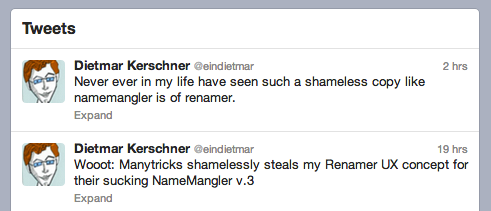Late in the day on March 1st, we received an explanation/apology from Dietmar Kerschner.
As far as we’re concerned, the personal side of this matter is now closed.
Two days ago, we launched Name Mangler 3, our first major upgrade to the program in nearly three years. This update was user-driven, based on feedback we’ve been tracking since Name Mangler 2 came out. We focused on speed, the ability to perform more than one renaming action, and some user interface improvements. We’re incredibly proud of what we built, and have been thrilled with the initial reaction.
Then yesterday, out of the blue, we received an email claiming we’d violated the copyright of another renaming application. We spent the afternoon researching the other app, and eventually sent an email response back to the accuser, clearly demonstrating our innocence through screenshots and app release timelines. (Name Mangler has existed in pretty much its current form since its initial debut as File List, way back in 2005.)
We thought that would be the end of it, because it was obvious there was no infringement. Today, though, we discovered that our accuser has gone public (despite not replying to our email) with these tweets:

Now that we’re being called thieves in a public forum, we feel we must respond in public as well: we cannot let Dietmar Kerschner trash our hard-earned reputation with baseless accusations that can’t withstand even the most basic level of scrutiny.
A Brief History of Name Mangler presents our side of the story. There you’ll find details on the development of Name Mangler, and that of Renamer(4Mac), the program whose designer has accused us of copyright infringement. Even a quick glance at the page will show that we’ve copied nothing from Renamer—if anything, we could claim that their latest release copied our design.
The purpose of this blog post, though, isn’t to go through a comparison of the two apps. Instead, we’d like to focus on the impact baseless copyright violation accusations have on both developers and (potentially) end users.
The threat
This is the threatening email we received from Dietmar Kerschner:
To whom it ma concern
I am Dietmar Kerschner, the UI/UX designer of Renamer 4. You have choosen to steal my UX concept for namemangler 3 which is a breach of copyright which i own.
It is abvious that you have stolen every part of the concept of Renamer 4, which i have concepted years ago.
I will not accept such copyright abuse.Please explain the situation and give a statement, otherwise i will have to forward this case to my lawyer.
You also would risk another abusement case which can be forwarded to incrediblebees laywers.I recommend to act fast.
Cheers
Dietmar Kerschner
The above is reproduced verbatim, typos and formatting and all. Here’s the actual email message, in case you think we might be making this up. Trust me, we wish we were.
Our response
Needless to say, this email made us extremely angry: we have never stolen a UI concept/design from anyone, ever, and we work incredibly hard on our user interfaces. There are literally thousands of hours of design work and rework in Name Mangler 3’s user interface, and all of it was done internally, without ever looking at our competition.
We spend hours sweating the tiniest of details, often having pages-long Messages conversations about a one-pixel alignment decision. We care about this stuff, and we think it shows in the quality of our applications. So to be accused of interface theft hits us deeply, and it hurts, even when such accusations are false.
But what really got us mad was wondering how often this type of thing goes unnoticed and unmentioned, and the receiver of such a letter simply gives in under the threat of legal action.
Impact on developers
Between the two of us, we’ve now spent the better part of a full day on this project, gathering historical data for File List/Name Mangler (very easy, as we keep everything) and Renamer (much harder, given the name and ownership changes, and the lack of any sort of release notes) and preparing our response to Dietmar.
We’ve been Googling and taking screenshots and generally wasting time, proving something that we knew to be true going in. We called on friends in the software development business, to make sure we weren’t overlooking something about our work that could lead to a copyright infringement claim. We reached out to fellow Mac developers, asking for their thoughts on the situation.
All of these things take time, and time is our most precious commodity. This is time that we could’ve been using to code, to respond to customer inquiries, to visit with family and friends, etc. All that time wasted, because of one threatening letter. And we took the time to respond. Imagine a smaller developer, with a greater fear of legal action. Instead of responding, they may start spending hours changing their app’s appearance—all for no reason at all, beyond a threatening letter.
We love the software business, we love developing excellent products, and we love fair competition between developers: end users benefit greatly when two or more companies are building apps that do similar things. But trying to smother the competition with a baseless copyright violation claim? That’s not how we play, and we don’t think it’s how the software business should work.
Impact on end users
You may think a developers’ debate over copyright violations has no impact on end users. And if your timeframe is very short, you’d be right. But in a slightly longer run, time that developers waste on needless tasks takes away from the time they have to spend supporting end users, to write cool new apps, to update old apps, etc.
In addition, every time a copyright violation accuser forces an unwarranted change in an application, they’re affecting the user experience. If an app is forced away from an ideal layout because someone claims it’s “theirs,” that’s not good for users.
Threats may also dampen a developer’s enthusiasm for developing in general; after all, it’s no fun to spend hours defending your actions under threat of legal action. Irk a developer enough, and they may just decide it’s not worth the hassle, leading to fewer applications available for end users.
Wrapping it all up
Are we arguing that copyright is unimportant, and developers should be free to steal from other apps without any negative effects? Certainly not. Copyright is very important, and violators should be called to the mat for theft.
In this case though, we’ve demonstrated that not only did we not steal, but that any theft may have very well been the other way around: Renamer 4’s “new” interface bears a striking resemblance to one we’ve been using since 2005. But honestly, we don’t care—we like competing on features, performance, and ease of use instead of with legal threats.
So what happens next in this dispute? We have no idea. In an idealized world, Dietmar realizes that he’s wrong in his assumptions, and sends us his apologies for making a false accusation. The chances of that happening, though, are close to zero.
What we hope is that through exposing Dietmar and his threatening but groundless copyright violations email, he’ll think twice before trying such an approach on other developers. This business is hard enough as it is without having to worry about such underhanded tactics.
Late in the day on March 1st, we received an explanation/apology from Dietmar Kerschner.
As far as we’re concerned, the personal side of this matter is now closed.
Because we view the issue as closed, we’ve closed the comments.
 Many Tricks
Many Tricks

Wow, nothing about either UI is profound or unique. A file list and a flow-chart like view that I’ve seen even before Apple’s Automator. Mr. Kerschner would do better to realize that he should just make his app as best as he can, and stop worrying about the non-stealing of generic UI ideas.
Bought your app to try to beat the troll.
You should know that your app doesn’t show up on the App Store with a search for “file renamer” but namemangler does…
There’s none so strange as folk. Diet mar needs to understand that man is a community, not a competition. Good luck to you both, Rob and Peter. Don’t let this get you down.
First let me say, important for you to understand is, that it was not my intention to harm peter and Rob, since i know myself what it means to build up a business and live of it. I do respect all of their work. And i truly do respect the time they spent into their explanation on this case.
I really respect every single developer or other kind of artist. But therefore it is very important for me to get my work respected from all those developers out there too. And trust me i had many cases where webpage designs, Logos, Icons, UI Designs and UX concept where shamelessly stolen from other devs. Maybe this made me misinterpret this case.
Now Namemangler was another case where i first thought of someone not respecting my work and this makes me angry as everyone else would get angry in that case.
What i want to say, sometimes people steal tings, and you learn from it, and in the end you maybe suspect someone to have stolen stuff, even if he maybe did not. Sorry for that.
Overall, it is something we maybe all can learn from, respecting others work (which ever) is not in any case bound to rights but to ethics and morals. Compare such cases with Apple/MS/Xerox in 1984 and you understand what i mean.
In the end, Good luck with Namemangler 3 and maybe a future version of Renamer. In General competition is there to revitalize the market but not to profit from the competition.
Cheers Dietmar
If I recall correctly, an interface cannot be copyrighted. CODE can be copyrighted – this prevents copy-paste of someone else’s code.
UI can be trademarked – if it’s novel, original and it’s formally filed as such. I don’t think either of you did that here.
“Trade Dress” can be trademarked, but that is not in play here.
Excuse me, I meant to say that UI can be patented – not trademarked.
Trade dress can be trademarked.
Dietmar, if you are indeed accepting that this was not theft, it might be worth asking for forgiveness, as well. Your response does not seem to contain the humility that would appropriately follow learning that you had made a public accusation without merit.
> [Dieter:]
> Apple/MS/Xerox
… which showed that an interface design is not copyrightable.
Microsoft ended up paying Apple damages for actual code they stole and patents they violated, not for look/feel, not for interface design. That is why, a few years later, Microsoft felt free to copy the NeXT interface design in Windows 95 and Windows NT 4.0.
Apple paid Xerox tens of millions of dollars before the Mac even shipped, but this case showed that Apple wasn’t bound to do that. Apple paid only for a private Xerox demo at PARC. Had Xerox actually released the Alto in 1981 instead of demoing it privately to Apple, then Apple would not have owed them anything.
Years after the Mac, Xerox started shipping computers, but the most money they made in computing was from Apple. So it worked out well for Apple and Xerox.
The reason Dieter is mixed up about this is that Microsoft justified their copying of Apple by saying Apple copied Xerox, while leaving out that Apple paid Xerox and Microsoft did not, and that became a famous trope. These days we have many online resources, including electronic books, so there is no excuse for getting this wrong.
Dieter, you screwed up. You don’t know the law. Apologize, take down your libelous Tweets, and get back to work.
In the future, talk to a lawyer FIRST. Only let the lawyer write legal letters, especially threatening ones. With law, you are expected to know you are right before you write something. Otherwise, you only increase your own liability. A legal letter from you can only hurt YOU.
Even though this incident may have already been settled, I’m dismayed that anyone would accuse Many Tricks of copyright infringement. Peter and Rob are recognized and appreciated by the Mac community as consummate, highly-ethical, tech professionals. Oh well, their minor kerfuffle made me aware of the 50% off deal on Name Mangler, which I purchased today.
Dietmar.
You really are a piece of work.
Apologise now.
Been a fan of Moom for a long time. This little dustup made me aware of the NameMangler deal, just bought a copy of the App Store. Good luck to you! Thanks for the great apps.
Just quit fighting and work together with a joint venture to share ideas.
Name Mangler is great, I’ve used it for years, but this blog post stinks of “PR stunt”.
I can certainly understand Dietmar’s position, even if he didn’t handle it well, but otherwise, what is his recourse? None. The old Indie Mac developer network uses to shame stepping on other developer’s toes, but that doesn’t exist anymore.
I also want to point out a little history Many Tricks has of “borrowing” ideas:
Moom’s pop-over when you over over the green button was taken from Deskovery.
Moom’s grid layout was taken from Divvy.
Moom’s snap feature was taken from Cinch (which was taken from Windows 7), but in this case Moom even copied the dotted-line branding that’s a Trademark of Cinch.
Coding has become a commodity and any innovation is weeks away from being ripped off. This is the world we live in now.
This was far from an publicity stunt: we had no desire to go public, and hoped that our response email would end the debate. But when we were called out as thieves on Twitter, we felt we had to reply to protect our reputation. And instead of just going “No, we didn’t,” we felt it best to share the facts and let readers decide if we’d done anything wrong. I would have had a much happier last two days had none of this happened, honest.
As for some claims about our other borrowing, here are some factoids that may or may not change your feelings on the matter:
Relative to copying Deskovery’s pop-over: Prior to your post, I’d never heard of Deskovery. I’m not sure if Peter’s heard of it, but I’m confident neither of us ever used it or saw it.
The grid layout isn’t copied from Divvy any more than a vertically-stacked reorderable sequence of commands is stolen from Automator. Our users asked us for grid-based resizing, so we added a grid. There are only so many ways to show a grid.
The snap feature was another Moom user request — neither Peter nor I use the feature ourselves, and really had no desire to have it in Moom. But it was our second-most requested feature (the first was the ability to move to other Desktops, for which there’s no public API available), so we added it.
As for the dashed outline, we actually had an email conversation with the author of Cinch when Moom 3 came out, explaining our dashed line. We already had a solid line that we were using for grid-based resizing, and wanted to distinguish snap-to-edges behavior with a different shape. We tried lots of alternatives, but in the end, a dashed line simply looked the best.
I’m sure you doubt every word I’ve written, but the above are the actual explanations for each feature you describe. Do coders borrow ideas from one another? Certainly; the presence of two or more programs in a segment is actually great news for consumers, because the programs will push each other to continually improve. (Look at Fusion and Parallels, which have a great history of both getting better and “being inspired” by elements of the others’ design.)
We have accomplished our objective with this campaign, and tomorrow, we’re going to discuss how to shut it down. We don’t want continued publicity from it, we just wanted acknowledgement of our innocence, and perhaps to make people think twice before threatening lawsuits over disagreements.
-rob.
I really appreciate your response and I do believe your words. You guys are very up-front and honest. My comment wasn’t meant to be an attack, just my own outlook on a customer driven industry where nothing is sacred.
When customers ask for these features, is your response ever “Our product does XYZ, and we do it very well. If you’re looking for ABC, you might look at product DEF by company GHI?”
I just question whether it’s truly in the customer’s best interest to continue adding feature and making a product less coherent when the problem is already solved, potentially better, elsewhere.
This is all “food for thought,” I don’t have the answer.
But in the case of Name Mangler, the new feature in question is a clear, logical progression of the product, regardless of where the idea came from.
We actually do that quite a lot. Our overriding goal is always simplicity and ease of use, so we turn down a lot of requests — Moom, in particular, inspires a large amount of feedback asking for fine-grained control over all aspects of the UI. But doing so would turn it into a Linux app, so we resist :).
However, in the case of the Moom features, the number of requests was in the hundreds for both grid and snap, so it seemed adding them was a must-do.
regards,
-rob.
Just to tie up a remaining loose end in this exchange: I did see and actually commented on Deskovery on Twitter.